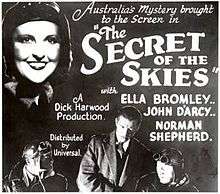Secret of the Skies
| Secret of the Skies | |
|---|---|
 | |
| Directed by | A. R. Harwood |
| Produced by | A. R. Harwood |
| Written by | Larry Brewer |
| Starring |
John D'Arcy Guy Hastings |
| Music by | The Early Victorians |
| Cinematography | Stan Pentreath |
| Edited by | A. R. Harwood |
Production company |
Centenary Films |
| Distributed by | Universal |
Release dates | April 1934 |
Running time | 56 mins |
| Country | Australia |
| Budget | ₤4,000[1] |
| Box office | £325[2] |
Secret of the Skies is a 1934 Australian film directed by A. R. Harwood about a bank robber who crashes a plane in remote bush. The story was inspired by the disappearance of the Southern Cloud in 1931.[3]
Plot
Hal Wayne, a bank clerk, has absconded with £10,000 of his bank's money. He hijacks a plane, the Golden Eagle, which crashes in the mountains. Wayne steals the remaining food and abandons the others to their death. He is driven half-mad in the wilderness and throws away his money before being found by a prospector and returned to civilisation. But he is haunted by guilt and three years later confesses to police.
Cast
- Paul Allsop as Larry Hamilton
- Norman Banks as first announcer
- Ella Bromley as Anne Walters[4]
- John D'Arcy as Captain Sinclair
- Jimmy Dee as Monty Wright
- Guy Hastings as Detective Palmer
- Fred Patey as Frederick Holtz
- Norman Shepherd as Hal Wayne
- Ada Koradgi as Miss Mckenzie
- Eddie Balmer as second announcer
Production
The film was partly shot in Cinesound Production's new studio facility in St Kilda, Melbourne in July 1933.[5][6]
Release
Harwood managed to arrange distribution through Universal although he later claimed that the release was delayed too long.[7] Critical reception was generally poor. One reviewer said:
If one is to spend an hour on a mountain top with seven, stranded travellers it is desirable that they should be amusing or interesting in some way or other. Except for the pilot (played extremely well by John Darcy) they are ill at ease, and their conversation is starchy. This conversational stiffness is emphasised by the lack of action, particularly on the part of the camera, which is set down in front of the unhappy party, and stays there without a movement for minutes on end. But the film has its moments of vitality. The actual crash is first-rate; and quite equal to similar instances in American pictures... In some of the scenes in the bush one is made to feel the remoteness of the travellers and the hopelessness of their position; but elsewhere stagey treatment and acting often rob the film of the spontaneity and the dramatic intensity it should have possessed.[8]
Despite a production cost of several thousand pounds the film only returned £325 to the producers.[9]
References
- ↑ Andrew Pike and Ross Cooper, Australian Film 1900–1977: A Guide to Feature Film Production, Melbourne: Oxford University Press, 1998, 165.
- ↑ "Counting the Cash in Australian Films"', Everyones 12 December 1934 p 19
- ↑ ""SOUTHERN CLOUD" Mystery For SCREEN.". The Australian Women's Weekly. National Library of Australia. 16 December 1933. p. 4. Retrieved 4 April 2012.
- ↑ "WHO ARE OUR POTENTIAL STARS?.". Table Talk (Melbourne, Vic. : 1885 - 1939). Melbourne, Vic.: National Library of Australia. 31 August 1933. p. 17. Retrieved 16 March 2015.
- ↑ "NEW FILM STUDIO.". Western Argus. Kalgoorlie, WA: National Library of Australia. 24 October 1933. p. 31. Retrieved 5 April 2012.
- ↑ "No. 1. Our Chances for World Markets.". Table Talk (Melbourne, Vic. : 1885 - 1939). Melbourne, Vic.: National Library of Australia. 17 August 1933. p. 7. Retrieved 16 March 2015.
- ↑ "AUSTRALIAN FILMS.". The Argus. Melbourne: National Library of Australia. 6 January 1934. p. 20. Retrieved 5 April 2012.
- ↑ "FILMS REVIEWS.". The Sydney Morning Herald. National Library of Australia. 2 April 1934. p. 2. Retrieved 4 April 2012.
- ↑ "SOME SCREEN REFLECTIONS.". The Courier-Mail. Brisbane: National Library of Australia. 29 February 1940. p. 9. Retrieved 5 April 2012.
External links
- Secret of the Skies at IMDB
- Secret of the Skies at National Film and Sound Archive
- The Secret of the Skies at Oz Movies